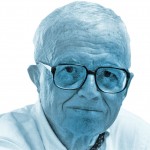
Two Sunday mornings ago, one of the last Sundays in the long Lenten season that prepares Christians for the promise of Easter, the reading from the New Testament in my church, St. Bartholomew’s, in Manhattan, was the passage from the Book of John in which a man born blind is given sight by an itinerant prophet named Jesus. When the man describes that experience he is rebuked by the Pharisees and other sticklers for correct procedure. Hounded for a proper explanation, he finally says: “One thing I do know: though I was blind, now I see.”
Every faith has a core of ancient parables and myths that tax the credulity of modern man. Yet most of them contain a grain of recognizable truth that we continue to believe on a different level—as metaphors that help us through the day. So it happened, on that recent Sunday morning, that I listened with new understanding to the old story of the man who was born blind. Last year I had surgery that largely restored my vision in an eye that would have soon gone blind from glaucoma. The world is still somewhat indistinct, but one thing I do know: though I was going blind, now I see pretty well. I’ve been blessed by the miracle of light.
The hymn that we sang after the reading was “Amazing Grace,” which, in its opening stanza, says:
Amazing Grace, how sweet the sound,
That saved a wretch like me.
I once was lost but now am found,
Was blind, but now I see.
I marveled once again at the simplicity of the old hymn, only eight bars long, its melody contained within an octave but unmistakable in its gratitude and joy. In his sermon the Rev. F. M. Stallings noted that “Amazing Grace” has long been a tenacious presence in American life and that it has always been identified with the phrase from the Book of John about the man who was born blind.
“Both the hymn and the Gospel turn on the possibility of a new life,” he said. “It’s not surprising that this biblical story appears so often in early Christian art—all those images found in dark catacombs so void of light–and that in most cases the image is used to illustrate baptism. We know from early records that, when new Christians were brought into the faith, the chapter that was read to them as preparation for baptism was this story of a man whose life was spiritually changed to a way of sightedness that made everything new.”
For Christians, Easter is the light at the end of the long, dark tunnel of Lent, a beacon of renewal. My mother, Joyce Knowlton Zinsser, came from a line of devout Maine and Connecticut Yankees. She thought it was a Christian obligation to be cheerful, and she managed that duty with unfailing grace to the end of her life, keeping to herself the physical and emotional aches and pains of her later years.
Today, at Easter, it occurs to me that she defined being “cheerful” as far more than just maintaining a positive and life-affirming nature. I now see that she made it her everyday task to generate light.

